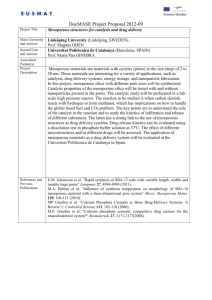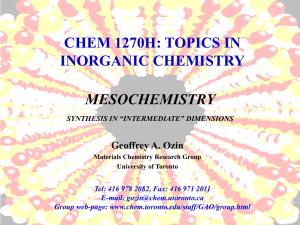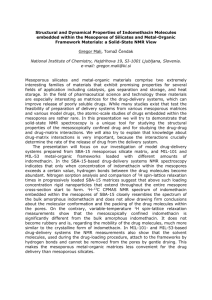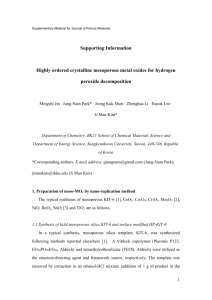Electronic supplementary information
advertisement
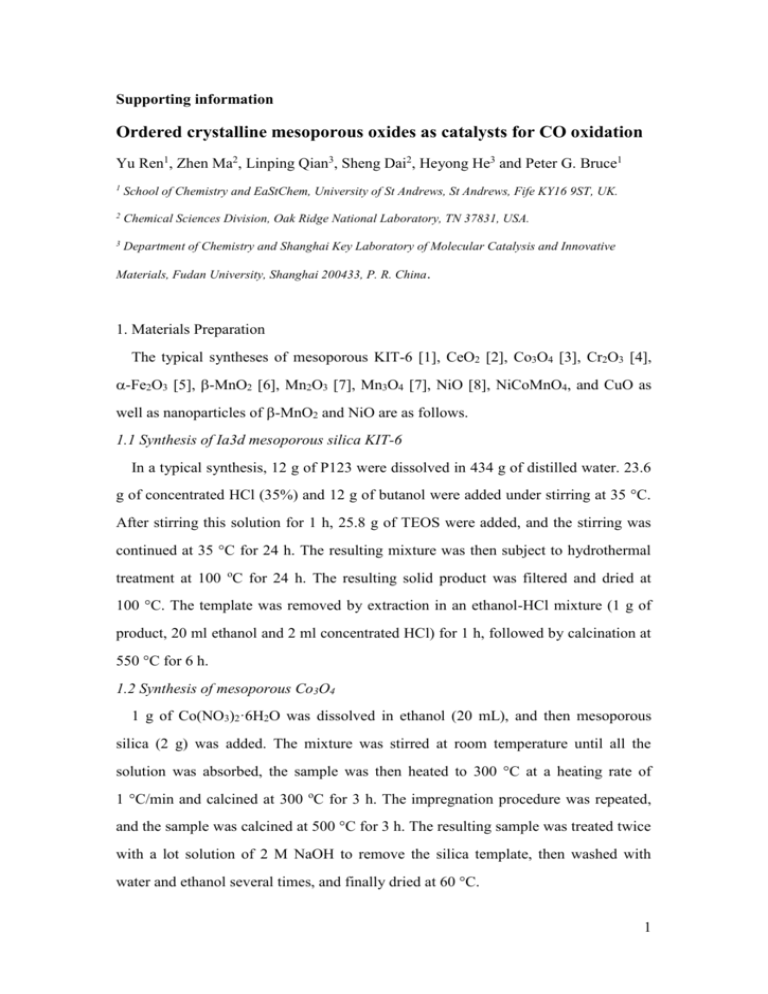
Supporting information Ordered crystalline mesoporous oxides as catalysts for CO oxidation Yu Ren1, Zhen Ma2, Linping Qian3, Sheng Dai2, Heyong He3 and Peter G. Bruce1 1 School of Chemistry and EaStChem, University of St Andrews, St Andrews, Fife KY16 9ST, UK. 2 Chemical Sciences Division, Oak Ridge National Laboratory, TN 37831, USA. 3 Department of Chemistry and Shanghai Key Laboratory of Molecular Catalysis and Innovative Materials, Fudan University, Shanghai 200433, P. R. China . 1. Materials Preparation The typical syntheses of mesoporous KIT-6 [1], CeO2 [2], Co3O4 [3], Cr2O3 [4], -Fe2O3 [5], -MnO2 [6], Mn2O3 [7], Mn3O4 [7], NiO [8], NiCoMnO4, and CuO as well as nanoparticles of -MnO2 and NiO are as follows. 1.1 Synthesis of Ia3d mesoporous silica KIT-6 In a typical synthesis, 12 g of P123 were dissolved in 434 g of distilled water. 23.6 g of concentrated HCl (35%) and 12 g of butanol were added under stirring at 35 °C. After stirring this solution for 1 h, 25.8 g of TEOS were added, and the stirring was continued at 35 °C for 24 h. The resulting mixture was then subject to hydrothermal treatment at 100 oC for 24 h. The resulting solid product was filtered and dried at 100 °C. The template was removed by extraction in an ethanol-HCl mixture (1 g of product, 20 ml ethanol and 2 ml concentrated HCl) for 1 h, followed by calcination at 550 °C for 6 h. 1.2 Synthesis of mesoporous Co3O4 1 g of Co(NO3)2·6H2O was dissolved in ethanol (20 mL), and then mesoporous silica (2 g) was added. The mixture was stirred at room temperature until all the solution was absorbed, the sample was then heated to 300 °C at a heating rate of 1 °C/min and calcined at 300 oC for 3 h. The impregnation procedure was repeated, and the sample was calcined at 500 °C for 3 h. The resulting sample was treated twice with a lot solution of 2 M NaOH to remove the silica template, then washed with water and ethanol several times, and finally dried at 60 °C. 1 1.3 Synthesis of mesoporous CeO2, -Fe2O3, and NiCoMnO4 1.5 g of Fe(NO3)3·9H2O or Ce(NO3)3·6H2O were dissolved in 20 mL of ethanol followed by the addition of 1 g of KIT-6. After stirring the mixture at room temperature until a nearly dry powder was obtained, the sample was heated slowly to 500 °C at a heating rate of 1 °C/min and kept at 500 oC for 6 h. The resulting sample was treated three times with a hot solution of 2 M NaOH, centrifuged, washed several times with water and ethanol, and then dried at 60 °C in an oven. The synthesis of mesoporous NiCoMnO4 is similar to that of crystalline mesoporous -Fe2O3 [5]. 1.5 g of an equi-molar mixture of Ni, Co and Mn nitrates was dissolved in 20 mL of ethanol followed by the addition of 1 g of mesoporous silica KIT-6. After stirring the mixture at room temperature until a nearly dry powder was obtained, the sample was heated slowly to 800 °C at a heating rate of 1 °C/min in air, and kept at that temperature for 5 h. The resulting sample was treated three times with a hot solution of 2 M NaOH to remove the silica template, centrifuged, washed several times with water and ethanol, and then dried at 60 °C. 1.4 Synthesis of mesoporous Cr2O3, -MnO2, Mn2O3, and NiO by the ‘two-solvent’ method Here the synthesis of mesoporous -MnO2 is shown as an example. 30 g of Mn(NO3)2•6H2O was dissolved in 20 mL of water to form a saturated solution. 5 g of KIT-6 was dispersed in 200 mL of dried n-hexane. After stirring at room temperature for 3 h, 5 mL of the saturated Mn(NO3)2 solution was added slowly with stirring. The mixture was stirred overnight, filtered and dried at room temperature until a completely dried powder was obtained. The sample was heated to 400 °C at a heating rate of 1 °C/min., calcined at that temperature for 3 h, and the resulting material treated twice with a hot solution of 2 M NaOH, followed by washing with water several times and drying at 60 °C. The only difference in the procedure for the other three metal oxides is the calcination conditions, Cr2O3: 500 °C for 5 h; Mn2O3: 600 °C for 3 h; NiO: 500 °C for 3 h. 1.5 Synthesis of mesoporous Mn3O4 by post reduction 2 Mesoporous Mn3O4 was obtained by reduction of mesoporous Mn2O3 at 280 °C for 3 h under 5% H2 / 95% Ar. 1.6 Synthesis of mesoporous CuO Mesoporous CuO was prepared by a nitrate combustion method [9]. 2.0 g of Cu(NO)3·2.5H2O was dissolved in 2.0 g of distilled water, and 1.0 g of KIT-6 was added. After drying at 100 °C for 1 h, the copper precursor-silica composite was exposed to the vapour from an aqueous ammonia solution at room temperature for 1 h and dried at 100 °C for 1 h. This impregnation-ammoniation-drying process was repeated twice more with aqueous solutions of 1.5 and 1.0 g Cu(NO)3·3H2O, respectively. The resulting copper precursor-silica nanocomposite was calcined at 400 °C for 6 h with a heating rate of 1 °C/min to obtain the CuO/silica nanostructure. (Caution: this reaction method involves combustion. A large open crucible should be used.) Finally, mesoporous CuO was obtained by treating the CuO-silica composite several times with a hot solution of 0.1 M NaOH, followed by washing with distilled water three times and absolute ethanol twice then drying at 60 °C for 2 h. 1.7 Synthesis of -MnO2 and NiO nanoparticles by carbonate decomposition Equimolar amounts of the precursor Mn(NO3)2·6H2O (or Ni(NO3)2·6H2O) and Na2CO3 were mixed together, and finely ground for 30 min in an agate mortar and pestle. Then the mixed solid was washed with distilled water 4-6 times, ethanol twice, and dried at 60 °C overnight. Finally the mixture was placed into a crucible, and heated in a muffle furnace from room temperature to 300 °C with a heating rate of 1 °C/min. The temperature was maintained at 300 °C for 2 h. 3 Fig. S1 N2 adsorption-desorption isotherms for the ordered crystalline mesoporous metal oxides: (a) CeO2, (b) Co3O4, (c) Cr2O3, (d) CuO, (e) Fe2O3, (f) MnO2, (g) Mn2O3, (h) Mn3O4, (i) NiO, and (j) spinel NiCoMnO4. The isotherms for CeO2, Co3O4, Cr2O3, CuO, Fe2O3, MnO2, Mn2O3, Mn3O4, NiO, and spinel NiCoMnO4 are offset vertically by 200, 150, 100, 50, 0, 250, 150, 100, 50, and 0 cm3/g, respectively for clarity of presentation. Reference [1] Kleitz, F.; Choi, S. H.; Ryoo, R. (2003) Chem. Commun. 2136 [2] Shen, W. H.; Dong, X. P.; Zhu, Y. F.; Chen, H. R.; Shi, J. L. (2005) Micropor. Mesopor. Mat. 85:157 [3] Jiao, F.; Shaju, K. M.; Bruce, P. G. (2005) Angew. Chem. Int. Ed. 44:6550 [4] Jiao, K.; Zhang, B.; Yue, B.; Ren, Y.; Liu, S. X.; Yan, S. R.; Dickinson, C.; Zhou, W. Z.; He, H. Y. (2005) Chem. Commun. 5618 [5] Jiao, F.; Harrison, A.; Jumas, J. C.; Chadwick, A. V.; Kockelmann, W.; Bruce, P. G. (2006) J. Am. Chem. Soc. 128:5468 [6] Jiao, F.; Bruce, P. G. (2007) Adv. Mater. 19:657 [7] Jiao, F.; Harrison, A.; Hill, A. H.; Bruce, P. G. (2007) Adv. Mater. 19:4063 [8] Jiao, F.; Hill, A. H.; Harrison, A.; Berko, A.; Chadwick, A. V.; Bruce, P. G. (2008) J. Am. Chem. Soc. 130:5262 [9] Ren, Y. (2007) First Year Report of Postgraduate, University of St Andrews 4
